 Weird Stuff
Weird Stuff  Weird Stuff
Weird Stuff  Mysteries
Mysteries 10 Tragic Disappearances and Deaths in Joshua Tree National Park
 History
History 10 Ways Childhood Really Sucked in the Old West
 Music
Music 10 Name Origins of Famous Bands from the 1990s
 Religion
Religion 10 Biggest Turnarounds by the Catholic Church
 Weird Stuff
Weird Stuff 10 Unbelievable Times Laws Had Unintended Consequences
 Humans
Humans Ten Historic Women Who Deserve Way More Credit Than They Got
 Movies and TV
Movies and TV 10 Films That Spawned Major Lawsuits
 History
History Ten Times Towns Were Wiped Off the Face of the Earth
 Creepy
Creepy 10 of the Most Disturbingly Haunted Public Houses in the UK
 Weird Stuff
Weird Stuff 10 Niche Subcultures That Are More Popular Than You Might Think
 Mysteries
Mysteries 10 Tragic Disappearances and Deaths in Joshua Tree National Park
 History
History 10 Ways Childhood Really Sucked in the Old West
Who's Behind Listverse?

Jamie Frater
Head Editor
Jamie founded Listverse due to an insatiable desire to share fascinating, obscure, and bizarre facts. He has been a guest speaker on numerous national radio and television stations and is a five time published author.
More About Us Music
Music 10 Name Origins of Famous Bands from the 1990s
 Religion
Religion 10 Biggest Turnarounds by the Catholic Church
 Weird Stuff
Weird Stuff 10 Unbelievable Times Laws Had Unintended Consequences
 Humans
Humans Ten Historic Women Who Deserve Way More Credit Than They Got
 Movies and TV
Movies and TV 10 Films That Spawned Major Lawsuits
 History
History Ten Times Towns Were Wiped Off the Face of the Earth
 Creepy
Creepy 10 of the Most Disturbingly Haunted Public Houses in the UK
10 Discoveries That Completely Baffle Modern Scientists
Every year, surprising discoveries are made all over our planet, in our solar system, and even farther out in the deep void of space. These findings push forward our understanding of the reality we live in, often challenging previous notions of universal physical laws.
When a discovery falls outside the boundaries of our understanding—sometimes with a lack of context—it will often stump the smartest experts. Here are 10 mysteries that are baffling modern scientists.
10 Giraffe Skin Disease

Since the 1990s, baffling cases of skin disease have affected giraffes in captivity and in the wild. It is a widespread condition in sub-Saharan Africa.
Experts are unable to determine if this mysterious ailment is due to a combination of diseases or if an environmental effect is in play. The scientific community still doesn’t know how this disease spreads, if it can be transmitted to other animal species, or if there is a cure.
Currently, Fred Bercovitch, director of Save The Giraffes, advises that this skin disease should not play a larger role in giraffe conservation efforts due to a lack of information as to how the condition affects the animals’ reproduction and mobility. A better understanding of the effect of this disease on the giraffe population could greatly increase conservation efforts in the future.[1]
9 East-Shifting Tornado Alley
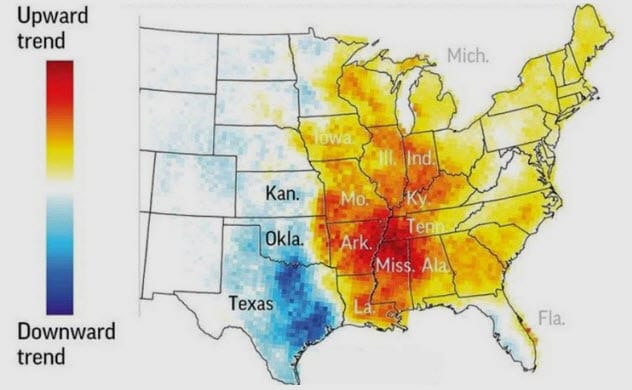
Areas east of the Mississippi River have seen an increase in tornadic activity over the last few decades. Meanwhile, states in the area commonly known as Tornado Alley have seen a significant decrease.
Although states like Oklahoma, Colorado, and Texas still have the most tornadoes each year, the total number has decreased since the late 1970s. The greatest decline has occurred in central and eastern Texas.
This change in atmospheric activity has led scientists to believe that Tornado Alley is shifting east, and they do not know why. Areas where tornadoes would often go unreported before the digital age are surprisingly the same regions seeing the largest decline in tornado activity.[2]
Victor Gensini of Northern Illinois University believes that the shift in Tornado Alley can be attributed to the drying of the Great Plains. Tornadoes form along the dry line where the dry air from the West meets the moist air from the Gulf of Mexico, a mixture that causes violent thunderstorms. As the dry line shifts east, so do the tornadoes.
However, it is unknown whether the shift is caused by our impact on the environment or an influence of nature.
8 Mysterious Seismic Waves
 Seismic waves were picked up worldwide by monitoring stations on November 11, 2018, causing scientists to speculate as to what caused this never-before-witnessed event. They were able to trace the initial location to Mayotte, a French island located between continental Africa and Madagascar.
Seismic waves were picked up worldwide by monitoring stations on November 11, 2018, causing scientists to speculate as to what caused this never-before-witnessed event. They were able to trace the initial location to Mayotte, a French island located between continental Africa and Madagascar.
This region has been plagued by earthquakes over the last year with a decrease leading up to the event. However, no earthquakes were reported to have occurred on November 11, especially nothing capable of producing the seismic signal. The strange signal was described as better representing a burst in energy than an earthquake.
Lasting roughly 20 minutes, the seismic waves traveled thousands of kilometers across the globe. They tripped earthquake monitors, although oddly enough, nobody aboveground was able to feel them.
As the signal was so unusual, its origin is difficult to determine. John Ristau, a seismologist at GeoNet, compared the Mayotte signal with that of the 6.3-magnitude North Atlantic earthquake. Although both signals were visible, they were very different in appearance.
As Ristau explained, “You can see that the amplitude of the [Mayotte] signal varies over time; however, the frequency, or period, of the signal is virtually uniform for the entire time. This implies a source that is producing a signal at one consistent frequency, but the strength varies.”[3]
Typically, an earthquake has a broad range of frequencies and periods at which it’s producing energy.
Anthony Lomax, an independent seismologist, suggested that the activity was probably caused by an undersea volcano to the north of Mayotte. Another possibility is an unacknowledged slow earthquake that kicked off the event.
7 The Antarctic Particles That Shatter Physics
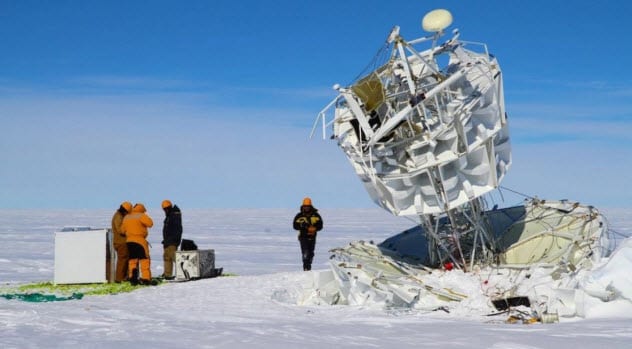
Physicists have observed a high-energy particle blast toward space from the ice in Antarctica, and they have no idea why or how this event happened. They believe that it must be some sort of cosmic ray.
The collection of particles that comprise the Standard Model of particle physics should not be able to travel this way. But this is exactly what was observed by NASA’s Antarctic Impulsive Transient Antenna (ANITA) in March 2016.
It is known that low-energy particles can travel miles through the Earth without being affected. But high-energy particles act differently because their large cross-sections make it likely that these particles will collide with something once they enter the Earth. As a result, they don’t make it out.
Most scientists suggest that ANITA captured a whole new type of particle. Some theories include an atypical distribution of dark matter inside Earth or a type of sterile neutrino which rarely collides with matter.
According to Penn State researchers who combined data from ANITA and IceCube, another Antarctica-based neutrino observatory, the particles bursting from the ice toward space have less than a 1-in-3.5-million chance of being a part of the Standard Model of particle physics.[4]
6 Persistent Noctilucent Clouds
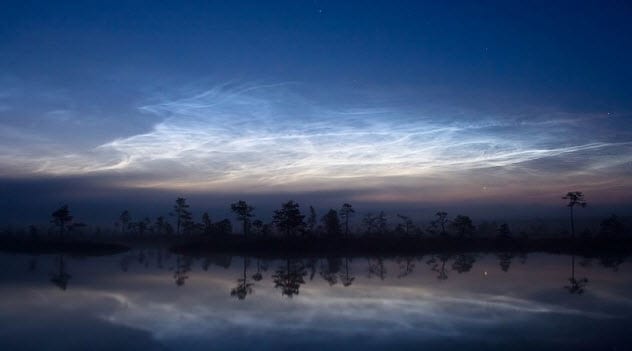
The mesosphere, the part of the atmosphere that almost touches space, is very cold and dry. During the summer, ice crystals about the size of cigarette smoke particles form around dust, possibly from meteoroids, in the -125 decree Celsius (-193 °F) conditions. When this happens, it creates a blue illuminating display of wispy clouds shortly after sunset called noctilucent clouds.
These fascinating clouds were first witnessed roughly two years after the eruption of Krakatoa in the 1880s. However, in 2006, scientists were able to answer the questions about their nature and formation.
Recently, a new mystery has sprung up about the persistence of the noctilucent clouds during the 2018 summer season. They are observed every year and have followed an expected routine—beginning their formation in May, intensifying in June, and dissipating by late July. It came as a shock to sky watchers across the northern hemisphere to see these spectacular night lights intensify in July and stick around long into August.
By using data from NASA’s satellite-based Microwave Limb Sounder, researchers from the University of Colorado realized that an increase in moisture is the cause of the prolonged effects of the noctilucent clouds. We do not know why there is an increase in moisture.
However, some theories are already in place. One involves an early entry into the solar minimum (originally expected in 2020), which may be associated with the coldest and wettest years in the mesosphere. Another possible explanation is planetary wave action in the southern hemisphere which causes more moisture in the northern atmosphere than one would usually expect.[5]
5 The Puzzling Hexagonal Vortex Of Saturn
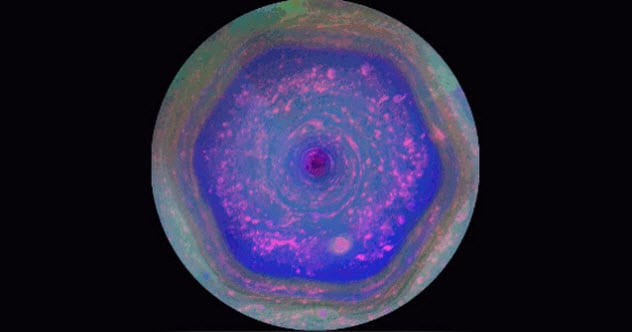
Analyzing data from the Cassini-Huygens mission that reached Saturn in 2004 and ended in 2017, researchers observed a strange hexagonal vortex forming at Saturn’s north pole as the northern hemisphere entered summertime. This vortex towered hundreds of kilometers above the clouds in the stratosphere.
In the 1980s, NASA’s Voyager spacecraft had discovered a hexagonal vortex much lower in the planet’s atmosphere, but they were astonished by the Cassini-Huygens finding. Leigh Fletcher of the University of Leicester explained:
While we did expect to see a vortex of some kind at Saturn’s north pole as it grew warmer, its shape is really surprising. Either a hexagon has spawned spontaneously and identically at two different altitudes, one lower in the clouds and one high in the stratosphere, or the hexagon is in fact a towering structure spanning a vertical range of several hundred kilometers.
A process called evanescence is one way for wave information to push up into the stratosphere, although its strength decays with height. According to our understanding of atmospheric sciences, however, a hexagonal vortex should not be able to push past the lower altitude clouds as wind directions change with higher altitudes.
Cracking the case on this geometric mystery will help scientists understand the transportation of energy around planets by grasping how the higher atmosphere is affected by the lower-altitude environment.
The Composite Infrared Spectrometer (CIRS) used on the Cassini-Huygens mission also revealed that Saturn’s poles exhibit surprisingly different behaviors. The south pole displays a vastly more mature circular vortex during the southern summer. This could indicate that Saturn’s northern vortex will continue to mature. Alternatively, Saturn may have asymmetrical poles that are yet to be understood.[6]
4 The Missing Dark Matter
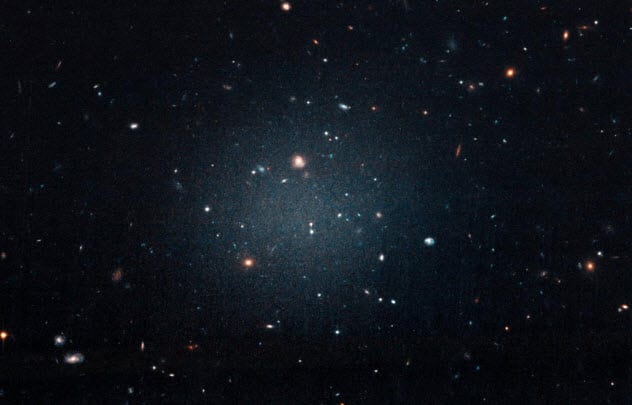
A team of scientists led by Pieter van Dokkum has discovered a galaxy named NGC1052-DF2 that appears to be lacking dark matter. This has astronomers scratching their heads because the absence of dark matter in this galaxy would confirm that the substance exists as well as produce doubts about our current understanding as to how a galaxy is created.
Our modern understanding is that galaxies are created from a halo of dark matter. Without dark matter, a galaxy should not be able to form.
The team was able to get a closer look and determine the mass of NGC1052-DF2, located 65 million light-years away, by tracking 10 embedded star clusters with the Dragonfly Telephoto Array. They found that the mass of NGC1052-DF2 was almost equal to the total mass expected from the stars (visible matter) within it. Also, the mass of NGC1052-DF2 is only 0.5 percent of the mass of our Milky Way galaxy.[7]
Some have suggested that dark matter may not exist and that we need to modify our understanding of gravity. However, alternate theories of gravity still have something that mimics dark matter on a galactic scale. In fact, it should always be there.
So, van Dokkum argues that if an alternate law of gravity applies to one galaxy, then that law should affect all galaxies in the same way. As a result, every galaxy should look like it has dark matter (even if it doesn’t) because the mimicking factor would always be there.
That leads us to van Dokkum’s paradoxical conclusion. If all galaxies should look like they have dark matter (even if it’s really something else), then the inability to detect dark matter in galaxy NGC1052-DF2 proves that dark matter is real. Scientists are still debating this issue vigorously.
3 The Deep Space Flashing Light
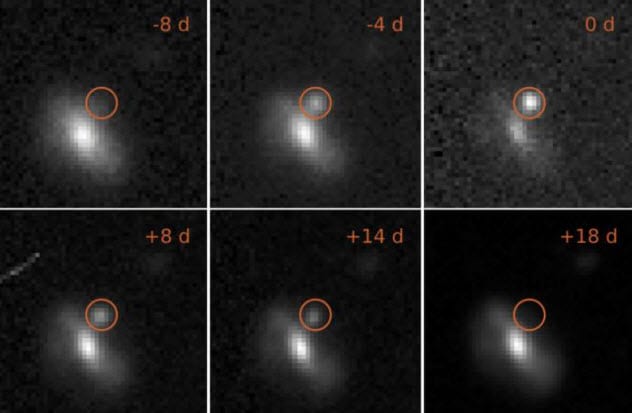
When astronomers were searching the depths of space to determine what comprises the 80 percent of the universe we can’t see, they stumbled across something unexpected. Seventy-two intense bursts of light were monitored from the Cerro Tololo International Observatory in Chile by Miika Pursiainen and his team.
The hot bursts of light were measured as being 300 million kilometers (186 million mi) to 15 billion kilometers (9 billion mi) across. They also had brightness that one would expect from a supernova, although they did not have the duration.
According to one theory, this event occurred due to a complication in the development of a Type II supernova. A Type II supernova happens when a star blows off its outer shell of gas after a buildup of heavy elements in the star’s core causes it to collapse in on itself.
This complication is currently being researched by the Australian National University. It has been named a fast-evolving luminous transient (FELT), which occurs when a star develops gas bubbles during the early stages of the collapse. When the star goes supernova, these gas bubbles explode due to the superheating effect. This is still a working theory, and only time will give us any definitive answers.[8]
2 Strange Infrared Light Emitting From A Pulsar
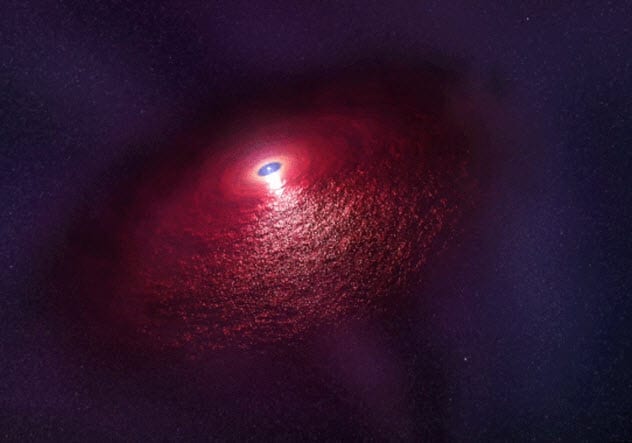
RX J0806.4-4123 is one of “The Magnificent Seven,” a group of X-ray pulsars located within 3,300 light-years from Earth. These pulsars are hotter and slower than astronomers would expect for their age.
RX J0806.4-4123 is emitting a strange infrared light that is completely new to scientists. When an international group of astronomers observed the pulsar with the Hubble Space Telescope, they noticed the extended area of roughly 29 billion kilometers (18 billion mi) of infrared light emitting from the pulsar.
Obviously, something more is going on with this neutron star as the infrared emissions are greater than the star alone can produce. So, what is the source of the energy? Scientists have proposed at least two theories: a fallback disk or a pulsar wind nebula.[9]
A fallback disk is a large disk of dust that formed around the neutron star after its explosion. Although such a disk has never been observed, researchers have hypothesized its existence.
It would explain the higher temperature and slower rotation of the star as well as the amount of energy needed to emit so much infrared light. A confirmation of the fallback disk would be a huge leap forward in our understanding of the formation of neutron stars.
Now let’s examine the pulsar wind nebula theory. The fast rotation of a neutron star with a strong magnetic field creates an electric field. In turn, when particles are accelerated in this field, a pulsar wind may be produced. Infrared emissions would then be emitted by shocked particles created when the neutron star travels at faster than the speed of sound through the interstellar medium.
However, the existence of an infrared-only pulsar wind nebula would be extraordinary.
1 The Bird In The Child’s Mouth

Fifty years ago, the remains of a young child were found in Tunel Wielki Cave in the Saspowska Valley in Poland. The child’s gender is unknown, but the skull of a bird was in the youngster’s mouth and another was by the child’s cheek.
Although the discovery was peculiar, the bones were almost immediately boxed and put into storage without being properly examined and assessed. The findings went unpublished except for a single photograph in a 1980s book by Professor Waldemar Chmielewski, the man who originally discovered the skeleton.
Anthropologists don’t know why the child was buried about 200 years ago in this manner or location. The only other human remains found in the cave were at least 4,000 years old.
The mystery doesn’t stop there. Although the University of Warsaw has bones from the youngster’s body, it does not have the child’s skull. In fact, it is missing. It was sent to anthropologists in Wroclaw after the excavation, but no one seems to know where the skull is now.[10]
Read about more mysterious and baffling discoveries on 10 Mysterious Discoveries That Could Completely Rewrite History and 10 Mysterious Discoveries That Still Puzzle Archaeologists.








